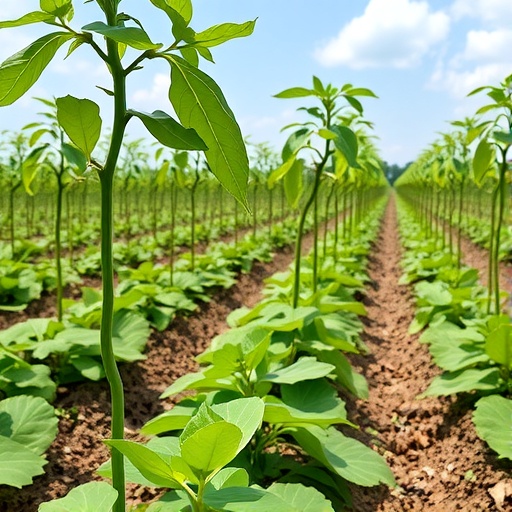In the lush landscapes of Southern Ethiopia, agriculture is both a vital source of sustenance and an economic driver for rural communities. However, farmers in this region are increasingly confronting the grim realities of moisture stress, a challenge that jeopardizes crop yields and water productivity. Recent research conducted by Otoro and Hatiye highlights the potential of supplemental irrigation to transform the fate of Haricot beans, also known as Phaseolus vulgaris, in these moisture-stressed areas.
The study harnesses the AquaCrop model, a sophisticated agricultural simulation tool developed to predict crop performance under various water management practices. This model stands as a beacon of hope for farmers who often depend on rain-fed agriculture, which remains highly vulnerable to unpredictable weather patterns exacerbated by climate change. As moisture stress becomes more frequent, the necessity for innovative irrigation strategies has never been more pressing.
The AquaCrop model serves as a digital test bed for exploring the relationship between irrigation and bean yields. By simulating different irrigation regimes, researchers can assess how supplemental water can enhance both yield and water use efficiency in Haricot beans. This is crucial, as beans are not only a dietary staple for many households but also a significant cash crop for vendors in markets across the region. Understanding how to optimize their yields through better water management could have profound implications for local economies.
One of the most compelling aspects of this research is its emphasis on sustainability. Water scarcity is a pressing global issue, and finding ways to maximize yield without overexploiting available water resources is essential. By employing the AquaCrop model, the researchers were able to simulate various scenarios, providing insights into how strategic water application can bolster bean production without compromising the long-term viability of local water supplies.
The findings reveal that even limited supplemental irrigation can lead to notable increases in yields. Farmers who implement practices suggested by the simulation may find their results significantly improved compared to traditional rain-fed methods. This means that small interventions in irrigation can lead to substantial improvements in food security for thousands of households.
Moreover, the research includes a comprehensive analysis of water productivity. This concept not only pertains to the yield per unit of water used but also embraces the broader implications of efficient water management practices. By focusing on water productivity, the study underscores the dual goals of increasing agricultural output while ensuring sustainability—a balancing act that is vital in regions where water is becoming increasingly scarce.
Attention to local climate conditions played a significant role in the study’s design. Southern Ethiopia experiences distinct rainy seasons, and understanding these patterns was critical for the simulation’s accuracy. The research team collected extensive meteorological data, which they integrated into the AquaCrop model to create a reliable forecasting framework. This approach highlights the importance of localized research in addressing global agricultural challenges.
The socio-economic context of the region cannot be overlooked either. Many farmers in Southern Ethiopia are smallholders who operate under the constraints of limited resources. Therefore, the recommendations stemming from this research aim not only to improve yield but to provide feasible strategies that can be adopted by farmers with varying capacities. The hope is that these findings will empower local communities to implement sustainable practices that enhance their agricultural resilience.
The potential impact of this research extends beyond immediate yield increases. Improved productivity can lead to enhanced income for farmers, better nutrition for families, and increased food availability in local markets. However, the transition to more sustainable water management practices will require a concerted effort that includes training, support, and resources for farmers to adapt to new techniques.
Connecting with local extension services can play a pivotal role in disseminating the findings of this study. Training programs focused on supplemental irrigation techniques can curb the learning curve for farmers who are accustomed to traditional methods. By equipping farmers with the knowledge they need to utilize the AquaCrop model’s insights effectively, the research could spur a paradigm shift in how farming is approached in moisture-stressed areas.
The collaboration between agricultural researchers and local farmers is crucial for ensuring that the findings are practically applicable. This partnership not only builds trust but also integrates traditional knowledge with scientific research, leading to innovative solutions that are culturally relevant and locally accepted.
As we look to the future of agriculture amid rising climate challenges, Otoro and Hatiye’s research stands out as a viable pathway forward. It illustrates the critical intersection of technology, sustainability, and economics, offering a blueprint that could be adopted in similar regions facing water scarcity globally.
Overall, the study encapsulates a message of hope and resilience. By leveraging technology like the AquaCrop model to inform irrigation practices, farmers in Southern Ethiopia can adapt to the changing climate and improve their livelihoods. The research serves as a call to action for stakeholders at all levels to invest in sustainable agricultural practices that ensure food security while safeguarding vital water resources for future generations.
In conclusion, this innovative study presents an exciting opportunity for the agricultural sector in Southern Ethiopia. By embracing supplemental irrigation based on sound scientific findings, farmers have the potential to considerably enhance their yields of Haricot beans, ultimately leading to sustainable improvements in local food systems.
Subject of Research: Effects of supplemental irrigation on Haricot bean yield and water productivity.
Article Title: Aqua crop model-based simulation of supplemental irrigation effect on Haricot bean (Phaseolus vulgaris L.) yield and water productivity in moisture stress areas of Southern Ethiopia.
Article References:
Otoro, G.G., Hatiye, S.D. Aqua crop model-based simulation of supplemental irrigation effect on Haricot bean (Phaseolus vulgaris L.) yield and water productivity in moisture stress areas of Southern Ethiopia. Discov Agric 3, 101 (2025). https://doi.org/10.1007/s44279-025-00274-9
Image Credits: AI Generated
DOI: 10.1007/s44279-025-00274-9
Keywords: supplemental irrigation, Haricot bean, Phaseolus vulgaris, water productivity, AquaCrop model, Southern Ethiopia, climate resilience, agricultural sustainability.




